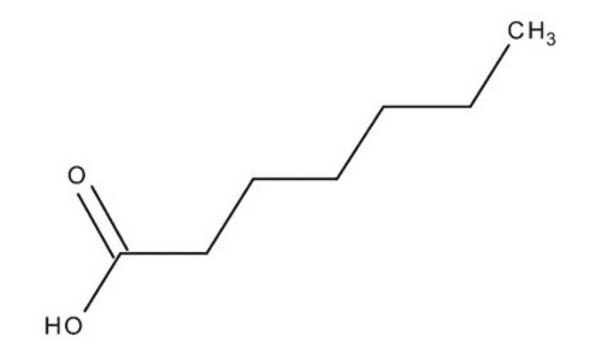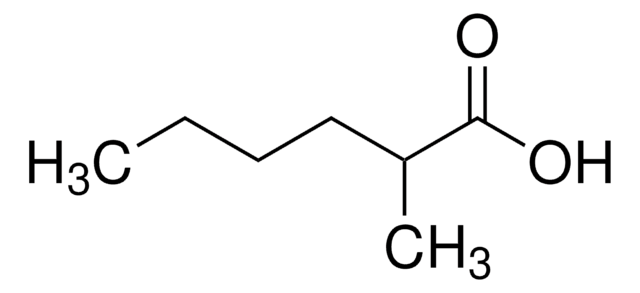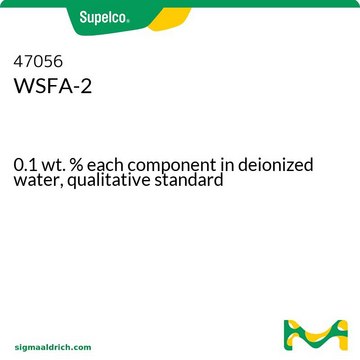75190
Heptanoic acid
≥99.0% (GC)
Synonyme(s) :
Enanthic acid, Oenanthic acid
About This Item
Produits recommandés
Densité de vapeur
4.5 (vs air)
Niveau de qualité
Pression de vapeur
<0.1 mmHg ( 20 °C)
Pureté
≥99.0% (GC)
Forme
liquid
Limite d'explosivité
10.1 %
Indice de réfraction
n20/D 1.4221 (lit.)
n20/D 1.423
Point d'ébullition
223 °C (lit.)
Pf
−10.5 °C (lit.)
Densité
0.918 g/mL at 25 °C (lit.)
Chaîne SMILES
CCCCCCC(O)=O
InChI
1S/C7H14O2/c1-2-3-4-5-6-7(8)9/h2-6H2,1H3,(H,8,9)
Clé InChI
MNWFXJYAOYHMED-UHFFFAOYSA-N
Vous recherchez des produits similaires ? Visite Guide de comparaison des produits
Application
- For esterification with glycerol to synthesize a triacylglycerol called as triheptanoin or trienanthoin.
- To synthesize 1-hexene via decarbonylation reaction by using platinum nanoparticles supported on carbon.
- To synthesize 7-tridecanone by ketonization in the presence of MnO2/CeO2 or ZrO2 catalysts supported on the surface of alumina.
Mention d'avertissement
Danger
Mentions de danger
Classification des risques
Acute Tox. 4 Inhalation - Eye Dam. 1 - Skin Corr. 1B - STOT SE 3
Organes cibles
Respiratory system
Code de la classe de stockage
8A - Combustible corrosive hazardous materials
Classe de danger pour l'eau (WGK)
WGK 1
Point d'éclair (°F)
235.4 °F - closed cup
Point d'éclair (°C)
113 °C - closed cup
Équipement de protection individuelle
Faceshields, Gloves, Goggles, type ABEK (EN14387) respirator filter
Certificats d'analyse (COA)
Recherchez un Certificats d'analyse (COA) en saisissant le numéro de lot du produit. Les numéros de lot figurent sur l'étiquette du produit après les mots "Lot" ou "Batch".
Déjà en possession de ce produit ?
Retrouvez la documentation relative aux produits que vous avez récemment achetés dans la Bibliothèque de documents.
Les clients ont également consulté
Articles
Separation of Propionic acid; Acetic acid; Heptanoic acid; Isobutyric acid; Valeric acid; Isocaproic acid; Butyric acid; Isovaleric acid
Separation of Methyl oleate; Caprylic acid; Heptanoic acid; Methyl decanoate; Methyl dodecanoate; Myristic acid; Methyl palmitate; Methyl palmitoleate; Methyl stearate; Methyl linoleate; Methyl linolenate; Acetic acid; Arachidic acid; Behenic acid; Propionic acid; Isobutyric acid; Valeric acid; Isovaleric acid; Isocaproic acid; Butyric acid
Protocoles
In this study, SPME was used for the analysis of free fatty acids in Parmesan cheese using a 65 μm Carbowax/divinylbenzene (DVB) SPME fiber. Headspace extraction of the cheese sample was conducted at 65 °C for 15 minutes and analyzed by GC with FID detection. SPME is ideal for analyzing the volatiles associated with solid food samples. The phase chemistry of the Nukol GC column provides excellent peak shape of acidic compounds.
Notre équipe de scientifiques dispose d'une expérience dans tous les secteurs de la recherche, notamment en sciences de la vie, science des matériaux, synthèse chimique, chromatographie, analyse et dans de nombreux autres domaines..
Contacter notre Service technique










